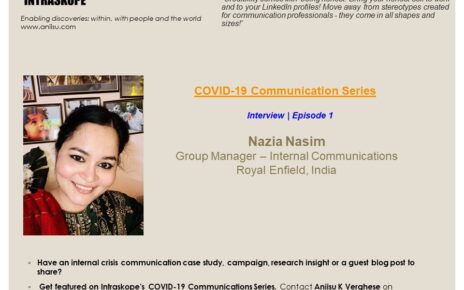No organization wants to come across as inauthentic – pretending to be a great place to work but internally lacking civility when dealing with staff, to begin with, and ignoring the ripple effect on stakeholders.
Anyone can spot when there is something amiss within. It just shows!
– When leaders are uncomfortable if colleagues have better ideas and are smarter than them
– When managers try to protect their turf because they fear they will lose their own value and importance
– When staff withhold information to ensure they are relevant and continue to retain their place in the organization
– When people see bad behavior and yet don’t want to call it out because they know the company will not protect whistleblowers
– When the office puts on a ‘dog and pony show’ for visiting leaders and then heaves a sigh of relief when they leave the door!
– When staff are exiting the firm because of poor ethics and treatment they receive within, irrespective of the ‘wonderful’ benefits on offer
Get a Grip on Your Company Culture
Organizations go south when leaders avoid accepting their faults, find ways to coast along, and create toxic environments stifling colleagues from thriving. That ends badly for the organization, always.
Losing talent isn’t the only issue. The reputation and poor word of mouth get carried beyond the workplace to forums where organizations would rather not like to be featured.
There is no point in doing employer branding in such cases because sooner than later it will catch up. In fact, in today’s world, the chances are it happens in real-time. Those who haven’t noticed should visit Glassdoor or, if you are in Poland, sites like GoWork to give you a glimpse of life within. Organizations and leaders can be dismissive of the comments on these forums – but is there smoke without fire?
A poor employer brand can make it difficult to attract and retain top talent. Job seekers today are pickier than ever, and they’re more likely to apply to companies whose values align with their own. A toxic culture is the strongest predictor of a negative Glassdoor review, and for example, 73% of US job seekers apply to a company only if its corporate culture aligns with their personal values.
But the risk of a toxic culture extends beyond poor Glassdoor reviews. Eighty-five percent of CEOs and CFOs believe that a toxic corporate culture could lead to unethical or illegal behavior, which could result in reputational damage and legal liability. Low corporate integrity is also associated with lower financial value.
Solve for Toxicity
So, what are the attributes that make a toxic culture? According to Glassdoor reviews, five attributes – disrespectful, non-inclusive, unethical, cutthroat, and abusive – have the largest negative impact on how employees rate their company’s culture. Each negative mention of these topics has a significant impact on an employee’s rating of their organization’s culture.
On the other hand, respect is the most frequently mentioned word in such reviews. This suggests that a culture of respect is highly valued by employees.
Job seekers today are looking for more than just challenging work and unicorn ambitions. They’re looking for companies that offer flexibility, inclusive benefits, and internal mobility. In fact, according to LinkedIn data, job seekers are viewing nearly twice as many job posts before applying than they did in 2019.
But before you start with employer branding, it’s essential to fix your company culture first. A poor culture leads to reputational disasters and poor word of mouth.
To avoid this, involve leaders in the process of fixing your company culture. Leaders need to be comfortable with the fact that their staff may have better ideas and be smarter than them. They need to be open to learning and development and create an environment where colleagues can be themselves.
Make your staff your advocates. If your employees are happy, they’ll be more likely to share positive feedback about your company. This will help you attract and retain top talent and build a strong employer brand.
Fixing your company culture should be the first step in any employer branding strategy. A toxic culture can have significant negative consequences for your organization, while a positive culture can attract and retain top talent and help you build a strong employer brand.
Like the article? Subscribe to my newsletter and join close to 6000 Linkedin followers who gain insights every week. Do share your comments as well.
Missed earlier articles on Employer Branding? Look them up here:
Employer Branding 101 | Begin with the Fundamentals
Employer Branding 101 | Address Key Issues Upfront
Employer Branding 101 | Debunking 4 Key Myths
Employer Branding 101 | Live Your Brand Promise
Employer Branding 101 | Is Your Organization Ready?
Interested in similar content? Look up my blog www.aniisu.com and website www.intraskope.com
Keen to get advice on communication and branding? Reach out to me: https://www.intraskope.com/advantage
Interested in getting stronger with your employer brand? Look up these resources.
Take a FREE Employer Branding Readiness Assessment and gauge where your organization stands.
· Learn: Internal Communications Fundamentals Course on Thinkific
· Internal Communications Series: https://forms.gle/KcqmPzLwq7NQi5Km6
· Chat with Aniisu – Internal Communications: https://www.instamojo.com/intraskope/connect-with-aniisu-60-minute-personalized-d/?ref=store
· Internal Communications workshops: https://bit.ly/2zdBRl1
#employerbranding #respect #culture #corporateculture #communications #engagement #experience #leadership #brand #reputation #internalreputation #Glassdoor #GoWork #wordofmouth #employeeadvocacy #employeeambassadors #authenticity #internalcomms #internalcommunications #talent #retention #talent



